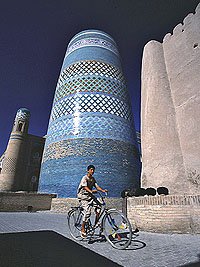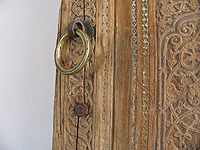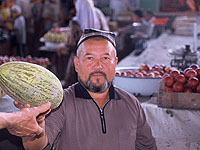 |
|
Uzbekistan - Khorezm Province |
||||
|
Established: 1938 The province is located in northwestern part of the country. It is one of the ancient areas of artificial irrigation, and prosperous cotton cultivating oases. It consists of 10 rural districts - Bogot, Gurlan, Koshkupir, Urgench, Khasorazp, Khonka, Khiva, Shovot, Yangyaryk, and Yangibozor; three cities - Druzhba, Urgench, and Khiva; seven town-type settlements, and 100 villages. The Urgench city is the administrative center of the province (1119 km away from Tashkent, 139,1 thousand people). Agriculture: cultivation of cotton, grain, rice, grapes, watermelon, and potatoes, livestock farming, and karakul sheep breeding. The natural conditions of Khorezm province are different from those observed in other provinces in the country. It is an island of green and prosperous oasis in northwestern and southwestern deserts of Uzbekistan. It is the most densely populated place in the lower streams of the Amu Darya River, and the most northern cotton cultivating area in the world. The province is located on flatlands of the Amu Darya delta. The climate is a sharp continental; the winter is moderately cold but with little snow. The summer is hot and dry. The temperature in winter drops to 32 degrees Celsius below zero, whereas in summer, it can reach up to 44 degrees Celsius above zero. Amu Darya is the only river, used for irrigation purposes. The province is not rich in natural resources; only some deposits of construction materials have been identified so far. The local economy is a large agricultural and industrial complex, Light and food industries are leading branches of economy. The cotton processing industry is also well developed. There are more than 107 major industrial enterprises, 7 joint ventures, as well as 1,427 small and 80 cooperative enterprises are now operating in the province. Cotton cultivation is the leading branch in local agriculture. It should be underscored, the province has the highest cotton yield in the country. It is also a leading rice cultivating area in Uzbekistan. Even though the watermelons, melons are cultivated in a limited area in the province, they are famous for their unbeatable taste throughout the world. The cocoon production in the province has its ancient roots. For centuries the area has been one of the finest silk material producers. The total length of the railroad network is 128,7 km, whereas the automobile roads are 3,800 km long, 3,500 km of which, is covered with asphalt. The Urgench city has one of the biggest international airports in the country. Education system of the province is well developed, as well. There are 508 general schools, specialized lyceums, gymnasiums, as well as sporting and musical schools. There is a State University, and branches of the Tashkent State University of Economics, and the Tashkent State Medical Institute in the province. Two theaters, 476 libraries, 333 clubs, 213 movie theaters and 2 museums serve the public. There is an "Icban-kala", the historical and architectural museum in the open air. More than 53 hospitals provide healthcare services. The province has few industrial centers and cities. The city of Urgench was once a village for small traders in the southern part of the Khiva khanate. The only thing it had was a small castle erected in 17th century. The main trade route of Urgench passed through the Amu Darya River and the Aral Sea. The route saw the export and import of various goods. Today's Urgench is a major cultural center. There are a lot of museums, clubs and theaters in the city. The Shovot canal runs through the city, which is the biggest irrigation construction in Khorezm. The city of Khiva - one of the beloved tourist destinations in the world - is located to the southwest of Urgench. Khiva is an ancient city-museum with lots of historical and architectural monuments and buildings. It is the only city-museum in Central Asia that is totally preserved in its glory and magnificence as an ancient city. The work of ancient masters of painting, wood carving and stone engraving can be seen in all of its historical monuments and buildings. The forms of majestic mosques, madrasah, palaces, and mausoleums create a unique ensemble. The palace of Tashkbauly, the Pakhlavon Makhmud mausoleum, the Allahkulikhan madrasah, and the Islamkhoja minaret fascinates the visitors with their glory. The city was established along the "Great Silk Road" in the 10th century. Later in the 12th century it became the capital of the Khiva khanate and for several centuries stayed as one of the major centers of Islam. The architecture of the city was formed not only upon traditions of Islamic architecture, but also on the basis of those with consideration of local customs, features, and climate, respectively. Constant affinity with nomad tribes, severe climatic conditions did affect the architectural buildings, and many private and manor houses, which reminded the small fortifications and castles. The city was built as a castle, and it always remained as that. Initially it was used to protect the local trade, later it became a refuge for the elite during riots and wars between local warlords. In the 19th century Khiva along with Bukhara was one of the major centers for religious studies, and there were many religious educational institutions in the city. Their architectural glory is still preserved. The architectural monuments and buildings of the city are constantly under care. There is always research and reconstruction going on in there. The Academy of Mam'un has been restored. In sum, the city hasn't become an empty city-museum or ghost town over these years, it has always been a lively place to stay. Hence, the contemporary Khiva became a city, where the history and modernity are living next to each other. |


